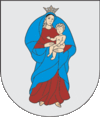Kretinga
| Kretinga | |||
|
|||
| State : |
|
||
| District : | Klaipeda | ||
| Rajong municipality : | Kretinga | ||
| Coordinates : | 55 ° 53 ′ N , 21 ° 15 ′ E | ||
| Community area : | 989 km² | ||
| Inhabitants (place) : | 21,460 (2008) | ||
| Inhabitant (municipality) : | 45,964 | ||
| Population density : | 46 inhabitants per km² | ||
| Time zone : | EET (UTC + 2) | ||
| Telephone code : | (+370) 445 | ||
| Postal code : | 97001 | ||
| Status: | Core city as city office, Rajongemeinde |
||
| Mayor : | Juozas Mažeika (since 2009) ( Tėvynės sąjunga ) |
||
| Website : | |||
|
|
|||
Kretinga (German: Crottingen , also: Krottingen, Krettingen ), located in the Curonian landscape of Megowe , is a city in western Lithuania in the immediate vicinity (11 km) of the Baltic Sea resort of Palanga and 25 km from the port city of Klaipėda . It is the core city and seat of the Rajongemeinde Kretinga .
history
The place was first mentioned in 1253 as Cretyn. Etymologically, the name is associated with "kritus" (swampy). City rights were granted in 1609.
Until the First World War, the border between Germany and the Russian Empire ran within today's urban area of Kretinga . The southern district of Bajorai ( German Bajohren ) belonged to the German Empire .
When the Memelland was separated from the German Reich in 1919 and Lithuania became independent at the same time , it became the border between these two newly created areas. In 1923 Lithuania annexed Memel Land and the border was obsolete.
From 1939, after the transfer of the Memelland to the German Reich as a result of the German ultimatum , the border ran again between the two places. In 1941, Kretinga was captured by German troops immediately after the start of the Russian campaign . By the autumn of 1941, more than 1,000 local Jews had been murdered by the Germans.
Attractions
- Museum of the City of Kretinga (since 1992 in the former manor house of Count Tiskevicius from 1875 with winter garden, orangery and manor park)
- Franciscan monastery, built between 1605 and 1610 with the Church of the Annunciation , built between 1610 and 1617, redesigned between 1907 and 1912
- Evangelical Lutheran Church , neo-Gothic brick / field stone building from 1897
- Cemetery chapel with the family tomb of Count Tiskevicius, neo-Gothic brick building from 1893 based on a design by the Swedish architect Karl Eduard Strandmann (1867–1946)
- Sculpture park
sons and daughters of the town
- Berek Joselewicz (1764–1809), Jewish colonel in the Polish army during the Kościuszko uprising
- Hans Lipschis (1919–2016), member of the Waffen SS in Auschwitz
- Vytautas Liutikas (1930–1997), politician
- Juozapas Algirdas Katkus (1936–2011), politician
- Henrikas Tamulis (* 1938), politician
- Antanas Vinkus (* 1942), politician, diplomat and mayor
- Modestas Paulauskas (* 1945), basketball player
- Arūnas Grumadas (* 1951), politician; Mayor of Vilnius
- Antanas Valys (* 1952), politician
- Rolandas Paulauskas (* 1954), politician and journalist
- Arvydas Salda (* 1955), politician
- Virginijus Česnulevičius (1956–2008), politician
- Gintaras Krapikas (* 1961), basketball coach and player
- Elena Petrošienė (* 1967), agronomist and politician
- Justina Vitkauskaitė (* 1978), politician
- Valdas Trakys (born 1979), football player
- Linas Pilibaitis (* 1985), football player
- Mindaugas Beinoras (* 1987), chess player
- Edgaras Slušnys (* 1991), badminton player
- Emilijus Krakauskas (born 1997), ice hockey player
literature
- Heinrich A. Kurschat: The book from Memelland , Siebert Oldenburg 1968.
- Hans Mortensen: Lithuania, basics of regional studies , Hamburg 1926.
- Wolfgang P. Schmid (Hrsg.): Nehrungskurisch, linguistic history and instrumentalphonetic studies on a dying dialect , Stuttgart 1989.
- LG Ulm, November 3, 1960 . In: Justice and Nazi crimes . Collection of German criminal judgments for Nazi homicidal crimes 1945–1966, Vol. XVI, edited by Irene Sagel-Grande, HH Fuchs, CF Rüter . Amsterdam: University Press, 1976, No. 499, pp. 775–831 Subject matter of the proceedings: mass and individual shootings of several thousand Jews and communists (men, women and children) on a 25 km wide strip in Memelland, immediately beyond the East Prussian region of that time -Lithuanian border in the first three months after the German troops invaded the Baltic States







